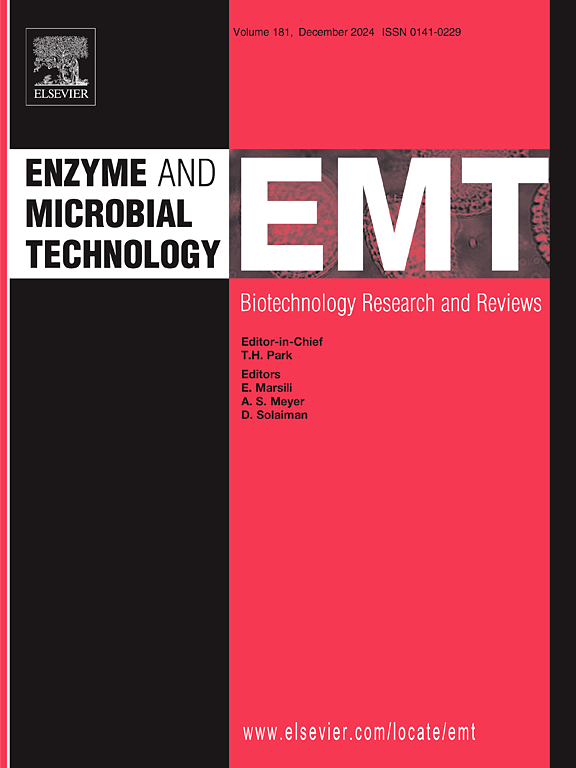在工程大肠杆菌中同时生产生物塑料和降解酶的一体化策略
IF 3.4
3区 生物学
Q2 BIOTECHNOLOGY & APPLIED MICROBIOLOGY
引用次数: 0
摘要
生物塑料是传统塑料的有希望的替代品,传统塑料严重污染环境,对生态系统产生不利影响。为了促进它们的使用,进一步研究生物塑料的生物降解是必不可少的。在这项研究中,我们提出了一种利用工程大肠杆菌在单细胞系统中同时生产聚羟基丁酸盐(PHB)和降解酶的新方法。通常,PHB解聚合酶,如PhaZ,会破坏细胞中的生物塑料合成,导致生产和降解的自我挫败循环。为了解决这个问题,我们从芽孢杆菌sp. JY35中合成了PHB的生产基因和三酰甘油脂肪酶(TGL),以及一个天然的信号肽用于分泌。这使得PHB在细胞内积累,而TGL被分泌到上清中。加TGL和不加TGL产生的PHB浓度相似(加TGL和不加TGL产生的PHB浓度分别为31.44 %和32.12 %)。TGL在大肠杆菌中有效分泌,对丁酸对硝基苯酯和辛酸对硝基苯酯的酯酶活性分别为7.1 U/mg和15.7 U/mg, 14 d内降解PHB膜的活性分别为30.1% %。此外,TGL在室温下储存30 d后,对C4和C8底物的活性分别保持了86 %和91 %,表明使用后降解PHB的潜力。我们的研究展示了一个简单的生物塑料生产和降解的一个月循环周期。本文章由计算机程序翻译,如有差异,请以英文原文为准。
An all-in-one strategy for the simultaneous production of bioplastics and degrading enzymes in engineered Escherichia coli
Bioplastics are promising alternatives for traditional plastics, which contribute significantly to environmental pollution and have a detrimental impact on ecosystems. To advance their use, further research into bioplastic biodegradation is essential. In this study, we propose a novel approach for simultaneous polyhydroxybutyrate (PHB) and degrading enzyme production in a single-cell system using engineered Escherichia coli. Typically, PHB depolymerases, such as PhaZ, disrupt bioplastic synthesis in cells, leading to a self-defeating cycle of production and degradation. To counter this, we introduced synthetic PHB production genes and triacylglycerol lipase (TGL) from Bacillus sp. JY35, along with a native signal peptide for secretion. This enabled PHB accumulation inside the cells while TGL was secreted into the supernatant. The concentrations of PHB produced with and without TGL were similar (31.44 % PHB with TGL and 32.12 % PHB without TGL). TGL was efficiently secreted in E. coli, achieving specific esterase activities of 7.1 U/mg and 15.7 U/mg for p-Nitrophenyl butyrate and p-nitrophenyl octanoate, respectively, and degraded PHB film by 30.1 % over 14 d. Moreover, TGL retained 86 % and 91 % of its activities for the C4 and C8 substrates, respectively, after 30 d of storage at room temperature, suggesting potential use PHB degradation after use. Our study demonstrates a straightforward one-month circular cycle for bioplastic production and degradation by a single producer.
求助全文
通过发布文献求助,成功后即可免费获取论文全文。
去求助
来源期刊

Enzyme and Microbial Technology
生物-生物工程与应用微生物
CiteScore
7.60
自引率
5.90%
发文量
142
审稿时长
38 days
期刊介绍:
Enzyme and Microbial Technology is an international, peer-reviewed journal publishing original research and reviews, of biotechnological significance and novelty, on basic and applied aspects of the science and technology of processes involving the use of enzymes, micro-organisms, animal cells and plant cells.
We especially encourage submissions on:
Biocatalysis and the use of Directed Evolution in Synthetic Biology and Biotechnology
Biotechnological Production of New Bioactive Molecules, Biomaterials, Biopharmaceuticals, and Biofuels
New Imaging Techniques and Biosensors, especially as applicable to Healthcare and Systems Biology
New Biotechnological Approaches in Genomics, Proteomics and Metabolomics
Metabolic Engineering, Biomolecular Engineering and Nanobiotechnology
Manuscripts which report isolation, purification, immobilization or utilization of organisms or enzymes which are already well-described in the literature are not suitable for publication in EMT, unless their primary purpose is to report significant new findings or approaches which are of broad biotechnological importance. Similarly, manuscripts which report optimization studies on well-established processes are inappropriate. EMT does not accept papers dealing with mathematical modeling unless they report significant, new experimental data.
 求助内容:
求助内容: 应助结果提醒方式:
应助结果提醒方式:


